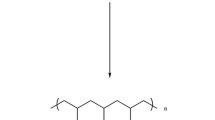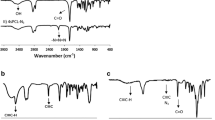Abstract
The aim of the current research work was to fabricate polymeric nexus for controlled delivery of metoprolol tartrate by using free radical polymerization. Polymer (aloe vera, sodium carboxymethyl cellulose, and meggletose) was crosslinked with monomer (acrylic acid) by using N,N methylene bisacrylamide. Swelling behavior was studied in pH 1.2 and 7.4. Sol gel fraction depicted gel fraction increased with the increase in feed ratio (polymer, monomer, and crosslinker). Optimized formulation was evaluated via Fourier transform infrared spectroscopy (FTIR) and scanning electron microscopy (SEM). FTIR confirmed compatibility of metoprolol with formulated system. Moreover, pH-dependent swelling was observed, experiencing significant swelling at higher pH. SEM depicted porous architecture which is responsible for swelling, drug loading, and release. Dissolution studies showed percentage drug release was significant in pH 7.4. Hence, the current research work demonstrates sustained delivery of metoprolol by employing varying concentration of polymer, monomer, and crosslinker. These fascinating properties made hydrogel a promising carrier for sustained drug delivery.
Graphic abstract

















Similar content being viewed by others
References
Bao Y, Ma J, Li N (2011) Synthesis and swelling behaviors of sodium carboxymethyl cellulose-g-poly (AA-co-AM-co-AMPS)/MMT superabsorbent hydrogel. Carbohyd Polym 84:76–82
Akalin O, Pulat M (2018) Preparation and characterization of nanoporous sodium carboxymethyl cellulose hydrogel beads. J Nanomater. https://doi.org/10.1155/2018/9676949
Liu P, Zhai M, Li J, Peng J, Wu J (2002) Radiation preparation and swelling behavior of sodium carboxymethyl cellulose hydrogels. Radiat Phys Chem 63:525–530
Biswas S, Biswas A, Galluzzi M, Shekh M, Wang Q, Ray B, Stadler FJ (2020) Synthesis and characterization of novel amphiphilic biocompatible block-copolymers of poly (N-isopropylacrylamide)-b-poly (l-phenylalanine methyl ester) by RAFT polymerization. Polym 203:122–760
Shekh M, Amirian J, Stadler F, Du B, Zhu Y (2020) Oxidized chitosan modified electrospun scaffolds for controllable release of acyclovir. Int J Biol Macromol 151:787–796
Dhanavel S, Praveena P, Narayanan V, Stephen A (2020) Chitosan/reduced graphene oxide/Pd nanocomposites for co-delivery of 5-fluorouracil and curcumin towards HT-29 colon cancer cells. Polym Bull 77:5681–5696
Dhanave S, Revathy A, Sivaranjani T, Sivakumar K, Palani P, Narayanan V, Stephen A (2020) 5-Fluorouracil and curcumin co-encapsulated chitosan/reduced graphene oxide nanocomposites against human colon cancer cell lines. Polym Bull 77:213–233
Ganna S, Raja S, Reddy G, Deva P, Raju B, Kummara M, Koduru M, John S (2021) Formulation, optimization, and in vitro characterization of omega-3-rich binary lipid carriers for curcumin delivery: in vitro evaluation of sustained release and its potential antioxidant behavior. Polym Bull 1:1–24
Amirian J, Zeng Y, Shekh M, Sharma G, Stadler F, Song J, Zhu Y (2021) In-situ crosslinked hydrogel based on amidated pectin/oxidized chitosan as potential wound dressing for skin repairing. Carbohyd Polym 251:117–125
Shahzadi K, Xiong W, Shekh M, Stadler F, Yan Z (2020) Fabrication of highly robust and conductive ion gels based on the combined strategies of double-network, composite, and high-Functionality cross-linkers. ACS Appl Mater Inter 12:49050–49060
Nayak A, Hasnain M, Dhara A, Pal, D (2021). (eds) Bioactive Natural Products for Pharmaceutical Applications. Advanced Structured Materials. Springer, Cham
Shiva K, Mandal S, Kumar S (2021) Formulation and evaluation of topical antifungal gel of fluconazole using aloe vera gel. Int J Sci Res Develop 1:187–193
Fonseca L, Dirlam P, Hillmyer A (2020) Atom-economical, one-pot, self-initiated photopolymerization of lactose methacrylate for biobased hydrogels. ACS Sustain Chem Eng 8:4606–4613
Jin X, Hsieh Y (2005) pH-responsive swelling behavior of poly (vinyl alcohol)/poly (acrylic acid) bi-component fibrous hydrogel membranes. Polym 46:5149–5160
Ijaz H, Tulain U, Minhas M, Mahmood A, Sarfraz R, Erum A, Danish Z (2020) Design and in vitro evaluation of pH-sensitive crosslinked chitosan-grafted acrylic acid copolymer (CS-co-AA) for targeted drug delivery. Int J Polym Mater 5:1–13
Ijaz H, Tulain U (2019) Development of interpenetrating polymeric network for controlled drug delivery and its evaluation. Int J Polym Mater 5:1099–1107
Zhong M, Liu T, Xie M (2015) Self-healable, super tough graphene oxide–poly (acrylic acid) nanocomposite hydrogels facilitated by dual cross-linking effects through dynamic ionic interactions. J Mat Chem B 3:4001–4008
Tayyab A, Mahmood A, Ijaz H, Sarfraz R, Zafar N, Danish Z (2020) Formulation and optimization of captopril-loaded microspheres based compressed tablets: in vitro evaluation. Int J Polym Mater 6:1–13
Ijaz H, Qureshi J, Danish Z, Zaman M, Abdel-Daim M, Hanif M, Mohammad I (2015) Formulation and in-vitro evaluation of floating bilayer tablet of lisinopril maleate and metoprolol tartrate. Pak J Pharm Sci 28:2019–2025
Ijaz H, Qureshi J, Danish Z, Zaman M, Abdel-Daim M, Bashir I (2017) Design and evaluation of bilayer matrix tablet of metoprolol tartrate and lisinopril maleate. Adv Polym Tech 36:152–159
Mahmood A, Ahmad M, Sarfraz R, Minhas M (2016) β-CD based hydrogel microparticulate system to improve the solubility of acyclovir: optimization through in-vitro, in-vivo and toxicological evaluation. J Drug Deliv Sci Technol 36:75–88
Chauhan P, Kumar A (2020) Development of a microbial coating for cellulosic surface using aloe vera and silane. Carbohydr Polym Tech App 1:1000–1015
Adinugraha M, Marseno D (2005) Synthesis and characterization of sodium carboxymethylcellulose from cavendish banana pseudo stem (Musa cavendishii LAMBERT). Carbohy Polym 62:164–169
Majeed A, Pervaiz F, Shoukat H, Shabbir K, Noreen S, Anwar M (2020) Fabrication and evaluation of pH sensitive chemically cross-linked interpenetrating network [Gelatin/Polyvinylpyrrolidone-co-poly (acrylic acid)] for targeted release of 5-fluorouracil. Polym Bull 12:1–20
Gami P, Kundu D, Seera S, Banerjee T (2020) Chemically crosslinked xylan–β-Cyclodextrin hydrogel for the in vitro delivery of curcumin and 5-Fluorouracil. Int J Biol Macromol 158:18–31
Gupta N, Shivakumar H (2012) Investigation of swelling behavior and mechanical properties of a pH-sensitive superporous hydrogel composite. Iran J Pharm Sci 11:481–485
Akhlaq M, Ullah I, Nawaz A, Safdar M, Azad A, Abbas S, Helaluddin (2020) Targeted Delivery of Methotrexate through pH-sensitive Hydrogel: To Treat Colon Pathology. doi:https://doi.org/10.20944/preprints202009.0510.v1.
Abad L, Relleve L, Aranilla C, Rosa A (2003) Properties of radiation synthesized PVP-kappa carrageenan hydrogel blends. Radiat Phys Chem 68:901–908
Bashir S, Teo Y, Ramesh S, Ramesh K (2017) Physico-chemical characterization of pH-sensitive N-Succinyl chitosan-g-poly (acrylamide-co-acrylic acid) hydrogels and in vitro drug release studies. Polym Degrad Stab 139:38–54
Azam F, Ijaz H, Qureshi J (2020) Functionalized crosslinked interpenetrating polymeric network for pH responsive colonic drug delivery. Int J Polym Mater 70:646–655
Ijaz H, Tulain U, Qureshi J (2018) Formulation and in vitro evaluation of pH-sensitive cross-linked xanthan gum-grafted acrylic acid copolymer for controlled delivery of perindopril erbumine (PE). Polym Plast Technol Eng 57:459–470
Ijaz H, Tulain U, Azam F, Qureshi J (2019) Thiolation of arabinoxylan and its application in the fabrication of pH-sensitive thiolated arabinoxylan grafted acrylic acid copolymer. Drug Dev Ind Pharm 45(5):754–766
Author information
Authors and Affiliations
Corresponding authors
Additional information
Publisher's Note
Springer Nature remains neutral with regard to jurisdictional claims in published maps and institutional affiliations.
Rights and permissions
About this article
Cite this article
Danish, Z., Ijaz, H., Razzaque, G. et al. Facile synthesis of three-dimensional porous hydrogel and its evaluation. Polym. Bull. 79, 7407–7428 (2022). https://doi.org/10.1007/s00289-021-03855-y
Received:
Revised:
Accepted:
Published:
Issue Date:
DOI: https://doi.org/10.1007/s00289-021-03855-y




